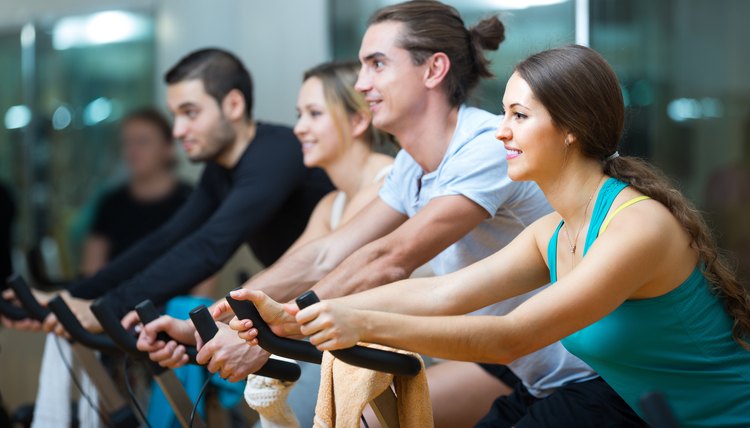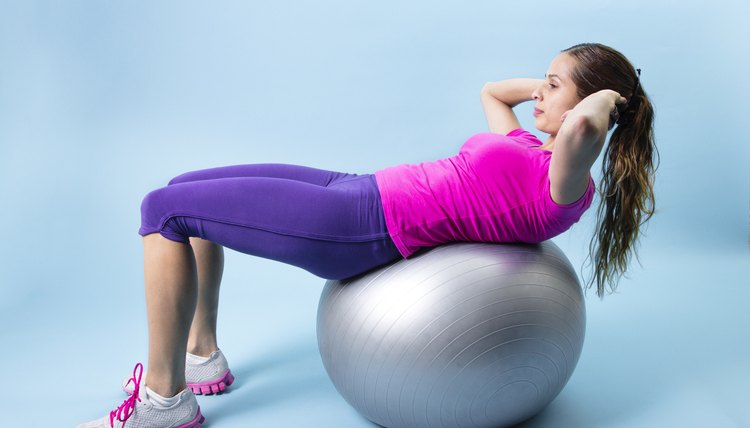What does fact checked mean?
At SportsRec, we strive to deliver objective content that is accurate and up-to-date. Our team periodically reviews articles in order to ensure content quality. The sources cited below consist of evidence from peer-reviewed journals, prominent medical organizations, academic associations, and government data.
The information contained on this site is for informational purposes only, and should not be used as a substitute for the advice of a professional health care provider. Please check with the appropriate physician regarding health questions and concerns. Although we strive to deliver accurate and up-to-date information, no guarantee to that effect is made.
How Does an Exercise Bike Tone Your Hips & Stomach?

Although new exercise contraptions come out frequently, the reliable exercise bike remains a favorite for a reason — it helps you get the physique you want without putting a lot of undue stress on your body. The muscles of your hips and stomach provide you with optimal position and power while pedaling an exercise bike. Riding the bike burns calories so you lose fat. Although you can't target your hips and stomach, this fat loss will help reveal these strong muscles.
As a bonus, an exercise bike is especially user-friendly. A bike meets you where you are physically, and you don't have to worry about being sidelined due to poor weather conditions — a bike in your basement or gym is always ready to go.
Weight-Loss Revelation
One of the biggest benefits of the exercise bike is its assistance in creating a caloric deficit. When you burn more calories than you consume through food and drink, your body uses stored fat for energy. As a result, you slim down and reveal toned hip and stomach muscles that have otherwise been hiding under excess fat padding.
Any aerobic exercise that raises your heart rate and causes a sweat helps you burn calories, but cycling on an exercise bike has a certain appeal. It's kind to your joints, which is especially important for people with osteoarthritis or who are 50 or more pounds overweight.
To lose significant weight to reveal your toned body, the American College of Sports Medicine recommends moderate-intensity aerobic exercise for at least 250 minutes per week. This is equivalent to about 45 minutes per day of modest pedaling. Crack open a book, watch your favorite show or join an indoor cycling class to keep you entertained.

How Does an Exercise Bike Tone Your Hips & Stomach?
Abdominal Stabilization
Your legs are obviously moving as you pedal, but your center — or core — is the place from which the energy generates. Your core includes your abs, as well as the low back and pelvic floor muscles. When you ride an exercise bike, your abs keep you stable and prevent unwanted rotation and upper-body movement. Riding the bike uses your abs and core for stabilization, but doesn't directly build these muscles like crunches or plank holds do.
Increase the activation of your abdominals during a bike ride by consciously drawing these muscles in toward your spine. This brace feels like you're getting ready to sneeze or cough. Doing a few 30- to 60-second drills standing in the pedals with a higher resistance, so you still have control, also builds abdominal stabilization and control.
After your cardio session on the bike, drop to the floor to do a round of the following exercises to make your center as strong as possible. You'll find you can ride the bike for longer, and thus burn more calories, when you've built a strong midsection.

How Does an Exercise Bike Tone Your Hips & Stomach?
- Stability Ball Crunch:Lie on a stability ball with your lower back supported by the ball. Place your hands behind your head and plant your feet securely on the floor. Crunch up and down with your torso for 10 to 15 repetitions. Work up to three sets.
- Hip Bridge: Lie on an exercise mat with your knees bent and head in the floor. Place your hands alongside your hips. Lift your buttocks and back up to make a straight line from your shoulders to your knees. Pause for a breath or two and release. Do this move 12 times, working up to three sets.
- Stability Ball Bird Dog: Balance your midsection on a stability ball, belly first. Your hands are flat on the floor and the toes tucked under behind you to form a long plank. Slowly raise your right arm and left leg; pause, then repeat with the opposite set of limbs. Continue to alternate for a total of 20 repetitions.
Hip Activation on the Exercise Bike
Riding an exercise bike works the muscles of your legs and your butt. To activate these muscles, your hips extend the thighs to push down during the first half of the pedal stroke.
While standing on the pedals challenges your balance to work your abs, it de-emphasizes your gluteus maximus and hip activity. When you're not doing the drills aimed at core stabilization, stay seated with your butt back in the seat to get the most work out of your hips. Increase the resistance for short periods, such as 3 to 10 minutes, to simulate climbing, which also forces your hips to work harder.
Strength train your hips to make them stronger for riding your exercise bike, too. Barbell squats, single-leg hip hinges and lunges are moves that will further your hip-toning goals.
References
Writer Bio
Andrea Boldt has been in the fitness industry for more than 20 years. A personal trainer, run coach, group fitness instructor and master yoga teacher, she also holds certifications in holistic and fitness nutrition.
